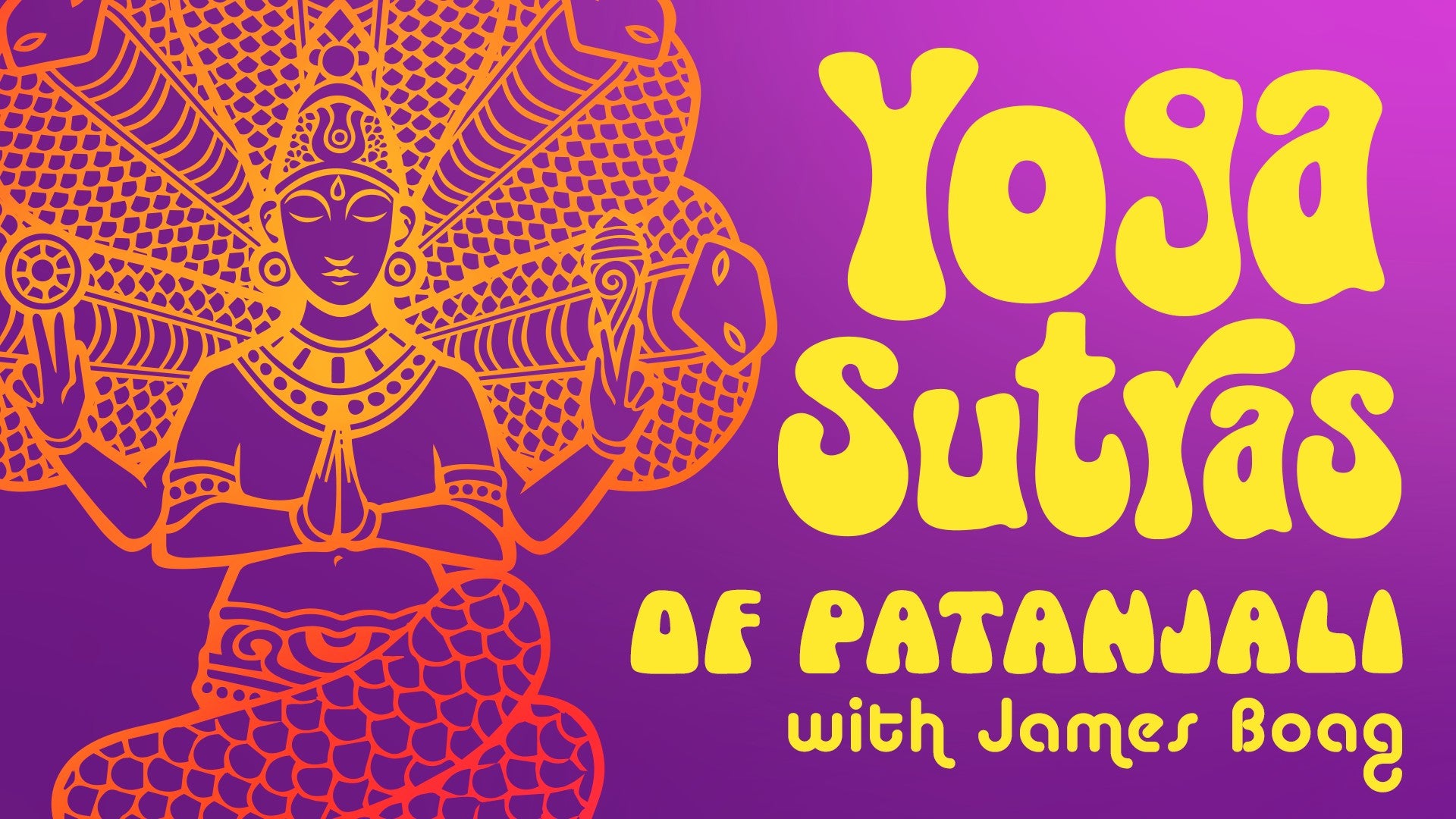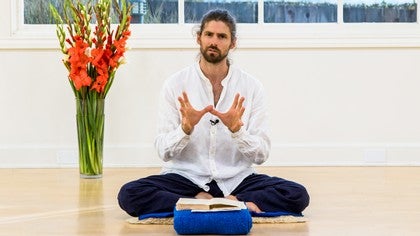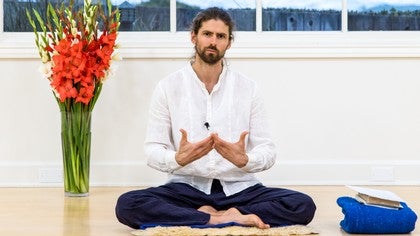Description
About This Video
Transcript
Read Full Transcript
So, we've finished the sixteenth sutra, or we haven't really, because you've never finished the sutras. This text, as we mentioned, it's not that we read it once and then we're done with it. Patanjali didn't write a pacy page turner that you read and then give to your neighbor. It's a work that you look at again and again. And so as we go through this course, we will recap again and again and we'll see things in slightly different light.
So we looked already at sutras twelve to sixteen in which Patanjali established the definition of practice, a pyaasa, and its effect or consequence, a vairagya. And in the twelve sutra Patanjali says, the two of these together, they are the means to bring about yoga or samadhi. So samadhi is basically synonymous with yoga and it means that state of balance, of evenness, of integration in which all the powers through which the light of our awareness, the light of our conscious power or capacity operates, when all those powers come into cohesion. And so Patanjali has said that the practice in order to facilitate that is a long-term, uninterrupted wholehearted effort to foster steadiness. And then he defined vairagya and he said vairagya is basically the consequence of practice.
So when you practice bringing all your parts into wholeness, when you remember yourself, when you bring all the members of the group into togetherness, all of the gunners, all of those group members of this being, all of the tatvas, all of those elements that constitute our embodied conscious essence or our embodied consciousness, when you bring them all into togetherness, naturally that brings with it an experience of wholeness or a sense of completion. So when we invite ourselves wholly, fully into the present moment, naturally there is a diminution of our thirst for some external source to bring us a sense of satisfaction. And this is the beauty of yoga practice, whatever situation we're in, wherever we are. If we allow ourselves to truly notice all the resources that we're actually carrying, and whatever is going on externally, it's easier for us to be relaxed about it, to just be with it. So what is it that makes a person thirsty, a sense of lack?
But if we practice being wholly in the present moment, being fully into whatever we are doing, then the moment can become its own fulfillment, and so we're less likely to be feverishly chasing external sources of satisfaction. And so the practitioner of yoga, the one that's making that constant, sustained effort to foster steadiness, that person basically practices being fully here and now in each unfolding moment of life. And consequently, the way that the external comings and goings can cast a spell over us diminishes, it reduces. And so this is the idea of vairagya, a diminution of desire for external things as a consequence of the practice of fullness. And then in the 16th sutra, it potentially emphasizes that when this vairagya culminates when it becomes more and more established, there arises a situation in which the yoga practitioner is not really troubled or overly perturbed by any of the changes in the realm of nature, prakriti, the realm of the gunas.
So Patanjali uses this word guna in the 16th sutra, and we haven't mentioned what gunas are yet. So gunas are these threads or strands or qualities of the natural manifest realm. So in the yoga system, nature, one of the ways that it's referred to is prakriti, manifestation. Nature and what does nature mean? If we think of the English word that's come through the Latin, nut, it means that which is born.
So sometimes if a lady is pregnant, they might say she's in a prenatal state. Salmon, this is being recorded in the United States. In the little bit further north, in the northwest, the salmon, when they run, they return to their natal stream, the stream where they were born. And nature is that which is born. And when something is born, what do we know is going to happen sooner or later?
It's going to die. And between these two great changes of coming into life being born and leaving life dying, one thing we can guarantee is change. And so the gunas are one way that the Indian philosophical system uses to describe the reality of the constant change of life, the constant change that is inevitable and always happening in nature. And so the idea is that everything in nature is constituted to some degree or is experiencing the influences of these three qualities. And they are satva, rajas, and tamas, satva guna, rajoguna, and tamoguna.
Rajas basically means energy or movement or dynamism. And because nature is moving, because life is pulsation, you can never really escape rajoguna. It's always present. And this means the two poles of satva on the one hand and tamas on the other, they are also never wholly the whole situation, because rajoguna is always there to some degree. So satva basically means the essence.
It's related to the verb to be. So it's the pure essence and it is light. And tamas on the other hand is dark and it's the force of inertia. So satva and tamas are relatively non-moving. But the pure essence, the light, and we've got the darkness, the inert force, the inertia.
But in between, we've got rajoguna. And the idea is everything in nature is always moving between these different qualities. And sometimes we feel drawn to stable luminosity, calm repose, towards satva for example. Sometimes we feel drawn to just passing out, tamoguna. Sometimes we feel drawn to activity, rajoguna.
But this is just an oversimplification really. The idea is that always these are influencing us. And so the idea is that when we look out at the world, it's always changing. But the one who's truly established, that person is residing, is dwelling in such close relationship with and awareness of the underlying conscious essence that regards to the comings and goings, that person does have a quality of great steadiness. And so that person is still experiencing all of the movement of life but is not trapped by it, is not bound by it.
Now when we hear such a description of a person who is unperturbed, unruffled by the comings and goings of life, at first glance, sometimes this can sound rather unrealistic maybe. And sometimes it can sound rather boring. Sometimes people say, well that doesn't sound much fun, you know, life is full of change and wonder and you're just always the same. And it's true that in yoga texts, the established yogin is described as always being the same. However, this might not necessarily mean what we first think it does.
It does not mean that the yogi is like an automaton, like a blank machine, always doing the same thing. What it means really is that the yogin, the established one, brings the same depth of open-hearted full presence to whatever is happening. And so what this means is that the deeply established practitioner experiences the whole spectrum of what life offers us more deeply because that person brings the same depth of presence to it. So it doesn't mean that life is boring at all. That yogin, that established practitioner, will experience grief more acutely and so process it more efficiently.
That person will experience joy more deeply but will not be bound by its after-effects, will not be hankering after recreating the same thing. Because that person is moving, operating, living in such a way that every unfolding experience can be its own reward, its own completion. And this idea of the action being its own completion, I think it's worth just elaborating for a moment here. So there is this idea that when we learn to live wholly in the present, we can stop creating the past. So let me explain what I mean here.
It's not that we don't have memories. It's not that we don't have experience. But the idea is when we live something fully, when we're fully here now, there's the idea that then at the end of that day we'll sleep easy because we fully did it. It's not that we look back and think, oh, I could have, I should have, oh, if only I'd done this. Why didn't I do that?
I knew I wanted to. Because the established one heeds the call of the conscience when it speaks. And so the established one brings that same authentic depth of presence to whatever life offers him or her. And consequently can go easily along the path without accruing more of a burden. So we experience things more deeply, but they leave less of an after effect.
The imprint they leave doesn't create a burden. So such is the description of somebody who becomes established in practice and its effect. Such a person who is, we might say, established in some degree of samadhi or yoga. So samadhi, this state of evenness, integration, and balance, if we're living in such a state where we can drink deep from the cup of life but not be bound by our experiences, this certainly sounds rather appealing to me. And so the question that then comes in then is, well, how does it work?
How can I deepen my experience of this? And so now in the 17th and the 18th sutras and henceforth, Patanjali is going to kind of deepen his explanation of how yoga works. And this is where we'll continue.
Yoga Sutras of Patanjali: Practice Wholeness
Comments
You need to be a subscriber to post a comment.
Please Log In or Create an Account to start your free trial.












